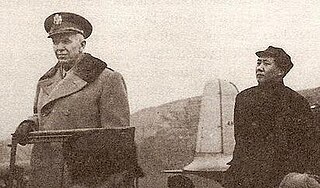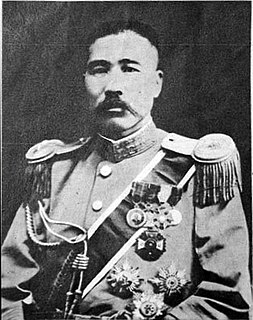 W
W19th Route Army was an army in the Republic of China led by General Cai Tingkai. It gained a good reputation among Chinese for fighting the Japanese in Shanghai in the January 28 Incident in 1932. In 1933-34 it was the main force in the Fuijan Rebellion, which opposed Chiang Kai-shek and unsuccessfully sought an alliance with the Chinese Communists in the Jiangxi Soviet.
 W
WThe 715 Incident, known by the Communist Party of China (CPC) as the 715 counter-revolutionary coup, and as the Wuhan–Communist split by the Kuomintang (KMT), occurred on 15 July 1927. Following growing strains in the coalition between the KMT government in Wuhan and the CPC, and under pressure from the rival nationalist government led by Chiang Kai-shek in Nanjing, Wuhan leader Wang Jingwei ordered a purge of communists from his government in July 1927.
 W
WThe Spirit Soldier rebellions of 1920–1926 were a series of major peasant uprisings against state authorities and warlords in the Republic of China's provinces of Hubei and Sichuan during the Warlord Era. Following years of brutal suppression, civil war, and excessive taxation, the rural population of central China was restive, and susceptible to militant salvationist movements. One spiritual group, the so-called Spirit Soldiers, promised the peasants that they could gain protection from modern weaponry through protective magic. Tens of thousands consequently rallied to join the Spirit Soldiers, and successfully revolted in the mountainous and isolated areas of Hubei and Sichuan. At its height, the Spirit Soldier movement numbered over 100,000 fighters, and controlled about forty counties.
 W
WThe Anti-Fengtian War was the last major civil war within the Republic of China's northern Beiyang government prior to the Northern Expedition. It lasted from November 1925 to April 1926 and was waged by the Guominjun against the Fengtian clique and their Zhili clique allies. The war ended with the defeat of the Guominjun and the end of the provisional executive government. The war is also known as either Guominjun-Fengtian War, or the Third Zhili–Fengtian War.
 W
WThe Central Plains War was a series of military campaigns in 1929 and 1930 that constituted a Chinese civil war between the Nationalist Kuomintang government in Nanjing led by Generalissimo Chiang Kai-shek and several regional military commanders and warlords that were former allies of Chiang.
 W
WThe Chinese Civil War was a civil war in China fought between the Kuomintang (KMT)-led government of the Republic of China (ROC) and the Communist Party of China (CPC) lasting intermittently between 1927 and 1949. The war is generally divided into two phases with an interlude: from August 1927 to 1937, the KMT-CPC Alliance collapsed during the Northern Expedition, and the Nationalists controlled most of China. From 1937 to 1945, hostilities were put on hold, and the Second United Front fought the Japanese invasion of China with eventual help from the Allies of World War II. The civil war resumed with the Japanese defeat, and the CPC gained the upper hand in the final phase of the war from 1945 to 1949, generally referred to as the Chinese Communist Revolution.
 W
WThe First United Front, also known as the KMT–CPC Alliance, of the Kuomintang (KMT) and the Communist Party of China (CPC), was formed in 1924 as an alliance to end warlordism in China. Together they formed the National Revolutionary Army and set out in 1926 on the Northern Expedition. The CPC joined the KMT as individuals, making use of KMT's superiority in numbers to help spread communism. The KMT, on the other hand, wanted to control the communists from within. Both parties had their own aims and the Front was unsustainable. In 1927, KMT leader Chiang Kai-shek purged the Communists from the Front while the Northern Expedition was still half-complete. This initiated a civil war between the two parties that lasted until the Second United Front was formed in 1936 to prepare for the coming Second Sino-Japanese War.
 W
WThe Han–Liu War was a major military conflict in late 1932 between the private armies of Han Fuju and Liu Zhennian over Shandong. Even though Han as well as Liu were officially subordinates to the Chinese Nationalist government in Nanjing, both were effectively warlords with their own autonomous territories. Han Fuju controlled most of Shandong and had long desired to also capture the eastern part of the province, which was held by Liu. The tensions between the two eventually escalated, leading to a war that saw Han emerge victorious. He went on to rule Shandong unopposed for the next six years, while Liu was exiled to southern China.
 W
WIn 1937 an Islamic rebellion broke out in southern Xinjiang. The rebels were 1,500 Turkic (Uighur) Muslims led by Kichik Akhund, tacitly aided by the 36th Division against the pro-Soviet provincial forces of Sheng Shicai.
 W
WThe Prince of Lu was part of the Southern Ming Dynasty, resisting the invading Manchu Qing dynasty forces. In 1651 he fled to Kinmen (Quemoy), in 1663 Kinmen was taken by the invaders.
 W
WThe Marshall Mission was a failed diplomatic mission undertaken by United States Army General George C. Marshall to China in an attempt to negotiate between the Communist Party of China and the Nationalists (Kuomintang) to create a unified Chinese government.
 W
WThe National Revolutionary Army, sometimes shortened to Revolutionary Army (革命軍) before 1928, and as National Army (國軍) after 1928, was the military arm of the Kuomintang from 1925 until 1947 in the Republic of China. It also became the regular army of the ROC during the KMT's period of party rule beginning in 1928. It was renamed the Republic of China Armed Forces after the 1947 Constitution, which instituted civilian control of the military.
 W
WThe Ngolok rebellions (1917–1949) were a series of military campaigns against unconquered Ngolok (Golok) tribal Tibetan areas of Qinghai (Amdo), undertaken by two Hui commanders, Gen. Ma Qi and Gen. Ma Bufang, on behalf of the Beiyang and Kuomintang governments of the Republic of China. The campaigns lasted between 1917 and 1949.
 W
WThe Republic of China Military Academy is the military academy for the army of the Republic of China, located in Fengshan District, Kaohsiung. Previously known as the Whampoa Military Academy, the military academy produced commanders who fought in many of China's conflicts in the 20th century, notably the Northern Expedition, the Second Sino-Japanese War and the Chinese Civil War.
 W
WThe Second Sino-Japanese War (1937–1945) was a military conflict that was primarily waged between the Republic of China and the Empire of Japan. In China, the war is known as the War of Resistance against Japanese Aggression, or as the oriental theatre of the World Anti-Fascist War, the latter term originating from Mao Zedong's wartime alliance with Stalin. The beginning of the war is conventionally dated to the Marco Polo Bridge Incident 7 July 1937, when a dispute between Japanese and Chinese troops in Peking escalated into a full-scale invasion. In 2017 the Ministry of Education in the People's Republic of China decreed that the term "eight-year war" in all textbooks should be replaced by “fourteen-year war", with a revised starting date of 18 September 1931 provided by the Japanese invasion of Manchuria. According to historian Rana Mitter, historians in China are unhappy with the blanket revision, and the Republic of China did not consider itself to be continuously at war with Japan over these six years.
 W
WThe Second United Front was the alliance between the Chinese Nationalist Party and the Chinese Communist Party (CCP) to resist the Japanese invasion during the Second Sino-Japanese War, which suspended the Chinese Civil War from 1937 to 1941.
 W
WCooperation between China and Germany was instrumental in modernizing the industry and the armed forces of the Republic of China between 1926 and 1941.
 W
WThe Sino-Soviet conflict of 1929 was an armed conflict between the Union of Soviet Socialist Republics and Chinese warlord Zhang Xueliang of the Republic of China over the Chinese Eastern Railway.
 W
WThe Sino-Tibetan War was a war that began in 1930 when the Tibetan Army under the 13th Dalai Lama invaded Xikang and Yushu in Qinghai in a dispute over monasteries. Ma clique warlord Ma Bufang secretly sent a telegram to Sichuan warlord Liu Wenhui and the leader of the Republic of China, Chiang Kai-shek, suggesting a joint attack on the Tibetan forces. Their armies rapidly overwhelmed and defeated the Tibetan Army.
 W
WThe Taiwan Garrison Command was a secret police/state security body which existed under the Republic of China Armed Forces on Taiwan. The agency was established at the end of World War II, and operated throughout the Cold War. It was disbanded on 1 August 1992.
 W
WThe war in Ningxia of 1934, also known as Sun Dianying Campaign, was a minor civil war for control over the Republic of China's province of Ningxia, fought between the warlord Sun Dianying and an alliance against him, consisting of the Ma clique, Governor Yan Xishan of Shanxi, and the Nationalist government of China. The conflict erupted as the unintended consequence of a plan by China's supreme leader, Chiang Kai-shek, to weaken the Ma clique, and resulted in the destruction of Sun Dianying's private army.
 W
WThe Warlord Era was a period in the history of the Republic of China when control of the country was divided among former military cliques of the Beiyang Army and other regional factions from 1916 to 1928.
 W
WThe Warlord Rebellion in northeastern Shandong was an uprising of several allied Chinese warlord armies under the leadership of Zhang Zongchang in 1929. The rebels wanted to regain their former territories in Shandong from Liu Zhennian, the man who had defected from Zhang to the Nationalist government in Nanjing during the Northern Expedition. After some initial successes, the rebels were defeated due to the indiscipline of their forces. In the end, the uprising failed to topple Liu Zhennian's rule over eastern Shandong, but resulted in high civilian casualties and widespread destruction at the hands of both sides in the conflict.
 W
WThe Warlord Era is the time period of China beginning from 1916 to the mid-1930s, when the country was divided by various military cliques, following the death of Yuan Shikai in 1916. Communist revolution broke out in the later part of the warlord period, beginning the Chinese Civil War. The era nominally ended in 1928 at the conclusion of the Northern Expedition with the Northeast Flag Replacement, beginning the "Nanjing decade". However, "residual warlords" continued to exist into the 1930s under de jure Kuomintang rule, and remained until the end of the Communist victory in 1949.